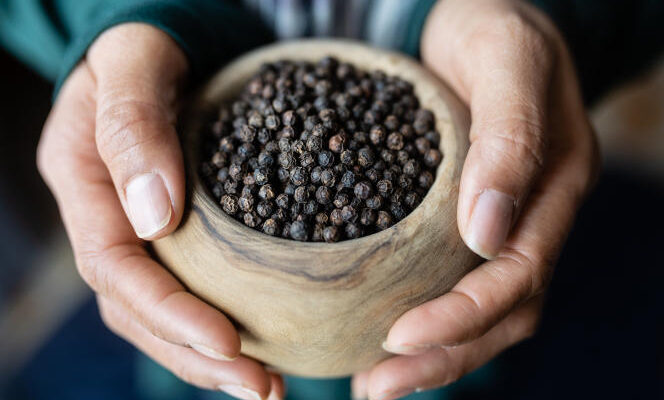If Vietnam is today the world’s leading producer and exporter of pepper, neighboring Cambodia can boast of growing, in the province of Kampot, in the south of the country, one of the most prestigious varieties of the eternal companion of salt.
It would be hard to find a Western chef capable of talking about prahok, this fermented fish paste, a central element of Khmer cuisine. But there are countless people (in France: Anne-Sophie Pic, Hélène Darroze, Olivier and Hugo Roellinger…) who praise these berries growing between the sea and (small) mountains.
Picked before maturity, the clusters of green pepper, with their very aromatic acidity, can be used fresh, sautéed in a wok, where their herbaceous touch works wonders with seafood (such as blue crab from Kep, a port near Kampot, which specializes). Preserved in brine to travel to us, the grains, with a saltier greenness, accompany grilled red meat or smoked fish.
But it is above all the different stages and drying techniques that allow these Khmer jewels to develop and refine aromas and flavors so prized by experts, that their spiciness, more delicate than many other piperaceae, is adorned with notes camphor and mentholated, as for the black pepper, with a sweetness of red fruits and candied orange, for the exceptional red pepper, or with a spicy warmth of grapefruit, for the white pepper.
“Kampot pepper comes back from afar”, recalls Hay Ly Eang contemplating the leafy creepers of the pepper plants, which wrap around the thousands of stakes. 3 meters high, they are lined up in one of the plantations of Confirel, the agri-food company that this Franco-Cambodian runs at the same time as his pharmaceutical products company, established in Phnom Penh. Not far from the port of Kep, overlooking the Gulf of Siam, “Doctor Hay” was one of the first to relaunch, on a large scale, the production of a pepper that was on the brink of extinction after years of glory.
“In the XIIIe century, the Chinese were already extolling the merits of pepper from the kingdom of Angkor »insists Hay Ly Eang, referring to the Memoirs on the customs of Cambodia, of the Chinese explorer Tcheou Ta-Kouan. But it was in the second half of the XIXe century that the culture of piper intensified in the Kampot region.
Reputation for excellence
First thanks to the Aceh War (1873-1904), in Indonesia, which saw the local sultan burn his pepper plantations so that they did not fall into the hands of the Dutch army. Part of the production would then have moved to southern Cambodia, where it developed and became industrialized under the impetus of French settlers. These will produce up to 8,000 tonnes a year of what they sell as “Indochinese pepper”.
You have 59.63% of this article left to read. The following is for subscribers only.
